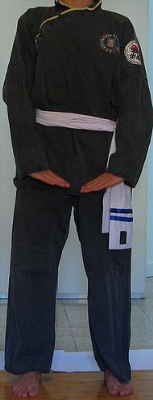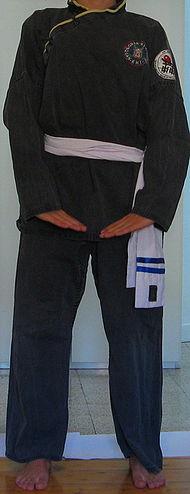
Quan Khi Dao
Encyclopedia
Qwan Ki Do also written Quan Khi Dao, is a Sino-Vietnamese martial art, founded in 1981 based on traditional martial arts styles.
It is said that Qwan Ki Do was named after Pham Xuân Tong's master: Châu Quan Ky.
It is the outcome of more than 25 years of studies and research from a Vietnamese martial arts expert: Pham Xuân Tong, executor of Châu Quan Ky's will.
The Chinese heritage is made out of three main schools of martial art:
The Vietnamese schools of martial arts are famous for their flying scissors
techniques and also for the 'free boxing' style,very close to the South East Asia fighting styles.
 Like in many other Vietnamese martial arts, Qwan Ki Do, doesn't have a colored belt system.
Like in many other Vietnamese martial arts, Qwan Ki Do, doesn't have a colored belt system.
It focuses on three levels, only to recognize the knowledge and experience of the student regarding technique:
The technique and the spirit of the student is tested.
The black belt continues his study focusing on individual training, studies of philosophy, psychology.
Starting from 1st DANG, the black belt, has a thin red edge (HUYEN DAI).
The student has to focus, besides the technique, on breathing techniques and individual training
It is above all grades in Qwan Ki Do and is a guarantee of ethics and authenticity of the style.
It consist of four colours representing the colours of traditional virtues in Qwan Ki Do:
Back of the fist : Binh Son
Bottom of the fist (Hammer Fist) : Thiet Chuy
Knife edge of the hand : Cuong Dao
Palm: Hung Chuong
Back of the hand : Binh Chuong
Forearm : Doc Moc
Elbow : Phuong Duc
Kick techniques : Cuoc Phap
Knee : Thiet Chuy Cuoc
techniques, animal forms such as Tiger (Ho), Crane (Bach Hac), Monkey (Hau Nhi), Snake (Xa), Dragon (Long) , Praying Mantis and others, as well as multiple weapon techniques with sword, staff (one-, two and three-parted), various knives and others.
Etymology
- Qwan: "the whole"
- Ki: "energy", also known as KhiQiIn traditional Chinese culture, qì is an active principle forming part of any living thing. Qi is frequently translated as life energy, lifeforce, or energy flow. Qi is the central underlying principle in traditional Chinese medicine and martial arts...
- Do: "the way", also known as DaoTaoDao or Tao is a Chinese word meaning 'way', 'path', 'route', or sometimes more loosely, 'doctrine' or 'principle'...
It is said that Qwan Ki Do was named after Pham Xuân Tong's master: Châu Quan Ky.
History and origins
Qwan Ki Do is the synthesis of four schools of martial arts from China and Vietnam.It is the outcome of more than 25 years of studies and research from a Vietnamese martial arts expert: Pham Xuân Tong, executor of Châu Quan Ky's will.
The Chinese heritage is made out of three main schools of martial art:
- SHAO LINShaolin kung fuShaolin Kung Fu refers to a collection of Chinese martial arts that claim affiliation with the Shaolin Monastery.Of the multitude styles of kung fu and wushu, only some are actually related to Shaolin...
or Thieu Lam, in which originated many different techniques, including jumping kick techniques or the CHIN NAChin NaChin Na or Qinna is a Chinese term describing techniques used in the Chinese martial arts that control or lock an opponent's joints or muscles/tendons so he cannot move, thus neutralizing the opponent's fighting ability...
or CAM NA techniques. - WO MEI or NGA MI, from the Mount EmeiMount Emei"峨眉山" redirects here. For the county-level city that Mount Emei is located in, see Emeishan CityMount Emei is a mountain in Sichuan province, China...
, that gave the grappling and projection techniques, and also animal fist techniques. - TANG LANGSouthern Praying Mantis (martial art)Southern Praying Mantis is a Chinese martial art native to the Hakka people...
or DUONG LANG, from southern China, typical of the HakkaHakka peopleThe Hakka , sometimes Hakka Han, are Han Chinese who speak the Hakka language and have links to the provincial areas of Guangdong, Jiangxi, Guangxi, Sichuan, Hunan and Fujian in China....
ethny, is based upon the praying mantis impression technique. It is characterised by fast attacks on the upper body, aiming at hitting vital spots and also dislocating articulations.
The Vietnamese schools of martial arts are famous for their flying scissors
Scissor kick (strike)
A scissor kick in martial arts is used to describe certain kicking or grabbing techniques that resemble a pair of scissors.-In The Asian Martial Arts:...
techniques and also for the 'free boxing' style,very close to the South East Asia fighting styles.
Code of Honour
As it can be found in the practitioner's guide.- To reach the high level of Qwan Ki Do technique by cultivating the notions of effort, perseverance, self-confidence, respect of the others, in the ancestral spirit of our martial art.
- To forge the body and the mind, for ourselves and for the others, without nourrishing our vanity and pride.
- To practice the moral vertues that make Qwan Ki Do: rightness/straightness of the soul,integrity, gratitude, simplicity, modesty and tolerance.
- To develop Qwan Ki Do according to the noble age-old traditions given from Master to Master, never to betray that spirit by individual pettiness that plant the seeds of disparagement, scission or dissidence in the method.
- To grow the notion of respect toward teachers, leaders and brotherhood between members.
- To consider martial art fights and free fights as a way to improve and not as an end in itself.
- To use the martial art for self-defence only.
- To rigorously apply the rules established by the World Union of Qwan Ki Do.
- To train assiduously, to respect the notions of hygiene and the Qwan Ki Do club's admission conditions.
- To respect all other martial arts.
Grades

It focuses on three levels, only to recognize the knowledge and experience of the student regarding technique:
- SO DANG or NHAP MON - initiation
- TRUNG DANG or TRUNG MON - medium level
- THUONG DANG or DAI MON - high level
SO DANG - White belt
The practitionner is at the beginning of its initiation. He is wearing a white belt, that symbolise his absence of knowledge.- Bach Dai - white belt - Vô Cuc - (the beginning, purity, void)
- Câp Một - blue barret on white belt - Thai Cuc (genesis, knowing the first basis,)
- Câp Hai - two blue barrets on white belt - Luong Nghi (attraction,duality, balance between the top level and the low level,Am Doung (Yin Yang) )
- Câp Ba - three blue barrets on white belt - Tu Tuong ( 4 cardinal points for 4 members of the body)
- Câp Bốn - four blue barrets on white belt - Ngu Hành ( the 5 elements, capacity of your body, difference between your body)
TRUNG DANG - Black belt
After accomplishing the exams for the 4th CÂP , the student can prepare for the black belt exam. The minimum age requirement is 16 years old.The technique and the spirit of the student is tested.
The black belt continues his study focusing on individual training, studies of philosophy, psychology.
Starting from 1st DANG, the black belt, has a thin red edge (HUYEN DAI).
The student has to focus, besides the technique, on breathing techniques and individual training
- 1 DANG: KIEN or NHÂT DANG or HANG MÔT
- 2 DANG : DOAI or NHI DANG or HANG HAI
- 3 DANG : LY or TAM DANG or HANG BA
- 4 DANG : CHAN or TU DANG or HANG BÔN
- 5 DANG : TON or NGU DANG or HANG NAM
CHUONG MON DAI - The Master's belt
This belt is inherited from generation to generation, it has been transmitted as a testamentary will, from Châu Quan Ky to Pham Xuân Tong.It is above all grades in Qwan Ki Do and is a guarantee of ethics and authenticity of the style.
It consist of four colours representing the colours of traditional virtues in Qwan Ki Do:
- BLUE - on the edge of the belt - it represents goodness and will
- YELLOW - second line after the blue colour - it represents clearness and intuition
- RED - covering the belt - representing courage and combativity
- WHITE - in the center of the belt -the synthesis of all colours represents purity
Natural Weapons used in Qwan Ki Do
Fist (two first phalanx) : Kho LauBack of the fist : Binh Son
Bottom of the fist (Hammer Fist) : Thiet Chuy
Knife edge of the hand : Cuong Dao
Palm: Hung Chuong
Back of the hand : Binh Chuong
Forearm : Doc Moc
Elbow : Phuong Duc
Kick techniques : Cuoc Phap
- Toe mound : Kim Tieu
- Sole of the foot : Ma Tuc
- Knife edge of the foot : Bang Tuc
- Heel : Thiêt Tieu
Knee : Thiet Chuy Cuoc
Techniques
Qwan Ki Do mostly uses hand-, foot-, jumping and scissorScissor kick (strike)
A scissor kick in martial arts is used to describe certain kicking or grabbing techniques that resemble a pair of scissors.-In The Asian Martial Arts:...
techniques, animal forms such as Tiger (Ho), Crane (Bach Hac), Monkey (Hau Nhi), Snake (Xa), Dragon (Long) , Praying Mantis and others, as well as multiple weapon techniques with sword, staff (one-, two and three-parted), various knives and others.

